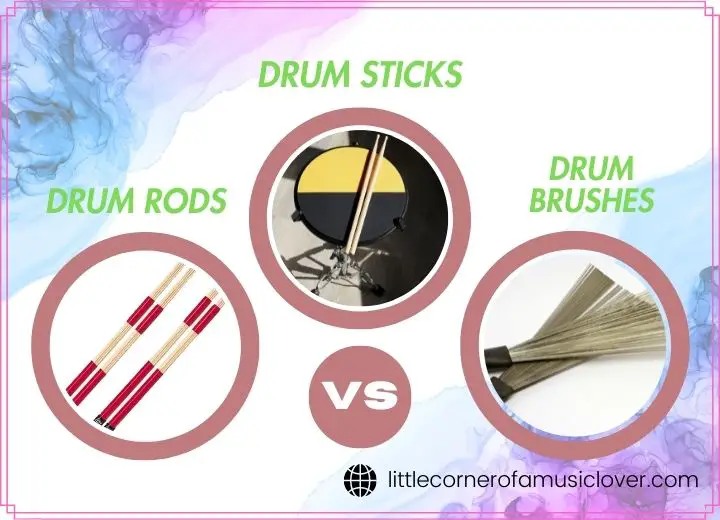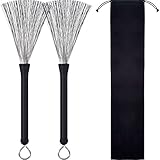Drum rods vs. sticks vs. brushes: which brings the best drumstick for your needs? How do they sound different? This post will answer all your questions.
Drum Rods Vs. Sticks Vs. Brushes: Comparison Table
|
Drum Rods |
Drum Sticks |
Drum Brushes |
|
| Suitable For |
|
|
|
| Sound Quality |
|
|
|
| Material |
|
|
|
| Pros |
|
|
|
| Cons |
|
|
|
What Are The Differences Between Drum Rods Vs. Sticks Vs. Brushes?
Features
The wooden drumsticks often come with maple or oak wood of various sizes and thicknesses. Meanwhile, the drum rots are made of multiple dowels in a cluster. For this reason, you should be more careful when using the sticks.
Hard materials like wood or metal create a stronger impact and louder sound volume. Still, they can damage your drum kit surface, especially the electronic drums.
Meanwhile, the rods and brushes are safer and lighter to play with. You also get more control over the attack and drawing when using the brushes or rods. In addition, they are commonly cheaper than drumsticks.
However, the high-end drumsticks bring more responsiveness and satisfaction, especially for powerful music genres like rock. The handle is more rigid and comfortable to hold, giving you a more solid playing style.
Sound Quality
The sound produced by the drumsticks is quite loud and straightforward, with a distinctive tone. Meanwhile, the drum rods are suitable for quieter playing with a medium sound volume.
Meanwhile, the drum brushes commonly feature nylon or metal bristles. There are also retractable drum brushes that provide better cover and protection for the bristles.
The sound drum rods generated when playing on the snare drum is quite similar to the drumsticks, except that they come in a lower volume. You may notice a unique chick sound when using the drum rods.
Meanwhile, the drum brushes bring a fun scratch sound, which is the quietest of the three categories. This sound quality is ideal for jazz and soft music, but you can still use a drum brush for various music genres.
On the symbol, the sound produced by drum brushes is more vibrating and light.
This video will demonstrate what the rods, sticks, and brushes sound like on a real drum kit to help you compare them easier.
Drum Rods Vs. Sticks Vs. Brushes: Which One Should You Choose?
The sticks, rods, and brushes are all prevalent drum tools used by the various drummers. Their sound quality is incredibly amazing. Therefore it is hard to tell which one is a superior option.
It boils down to your preference for the sound quality you are opting for. If you prefer the powerful and loud percussion sounds, then go for the drumsticks.
The drum rods and brushes are ideal for softer music genres like country, jazz, or blue. I recommend you try all these gadgets to pick the sound you like best.
FAQs
If you are still curious about these three percussion instruments, then the information provided in this section will be of great help. The answers give you more insights into the drumsticks, rods, and brushes.
What Are Drum Rods Used For?
Not just particular rock sounds, the drum rods can be used for any percussion instrument or type of drumming. These tools are ideal for drummers and jazz players.
The rods are suitable when the sticks sound too loud while the sound of brushes is too low. You can also use them for experimenting with the new kit’s textures.
How Often Do Drumsticks Break
It depends on your playing style and how careful you are with the drumsticks. Some drummers break their sticks on a weekly basis, while others keep their drumsticks intact for months or years.
However, the drumsticks will start wearing out and fraying over time. If your tool is too splintered, consider replacing it.
Do Electronic Drums Need Special Sticks
The short answer is no. The electronic drums are compatible with the majority of drumsticks’ materials and sizes. However, using wooden or metal sticks with your electronic drums is not recommended.
They are too solid and can damage the surface of your instrument.
Why Do Drummers Use Different Types Of Sticks?
The sound quality and playability of the sticks vary based on their sizes and materials. For example, the nylon sticks provide a lighter and brighter sound than the wooden ones.
Meanwhile, the wooden sticks give warmer and softer sound quality. Therefore drummers may opt for a certain type of stick for each soundtrack.
Why Do Drummers Use Brushes?
The brushes allow you to create sweeping sound effects in many grooves and patterns. The drummers use brushes when they want to play jazz and softer music like country, blue, or ballad.
What Are Hot Rod Sticks For?
The hot rod sticks are an ideal option if you want a medium sound between the loud sticks and the low-volume brushes. The sounds they bring are generally quiet and soft but not too small or crispy.




